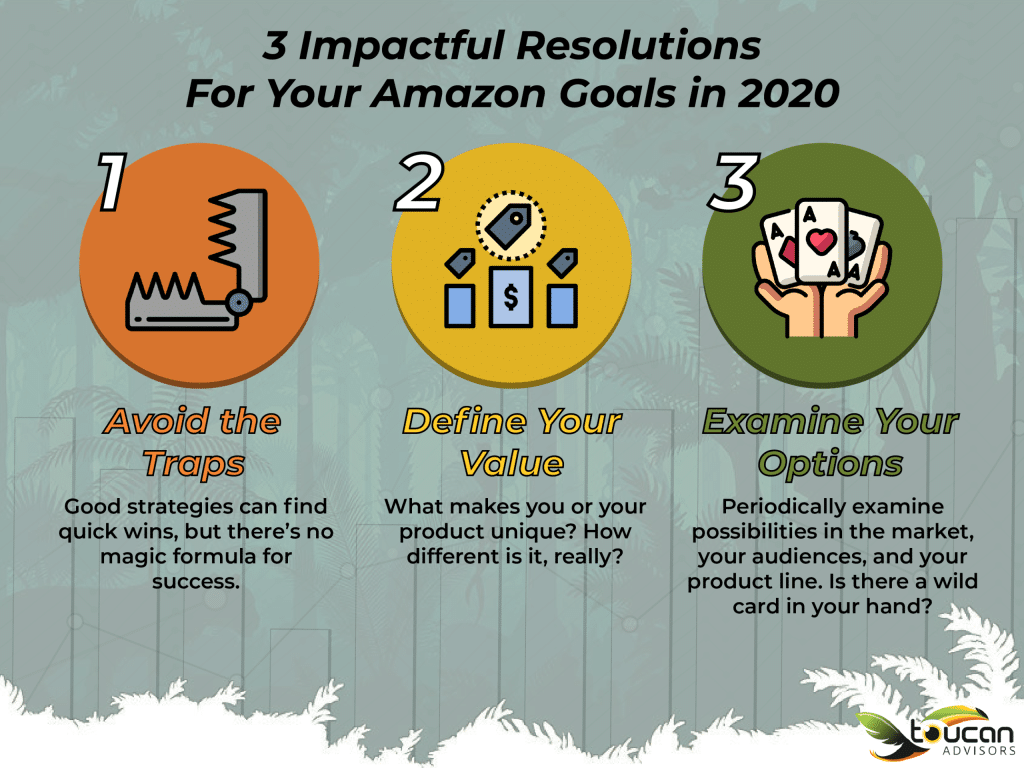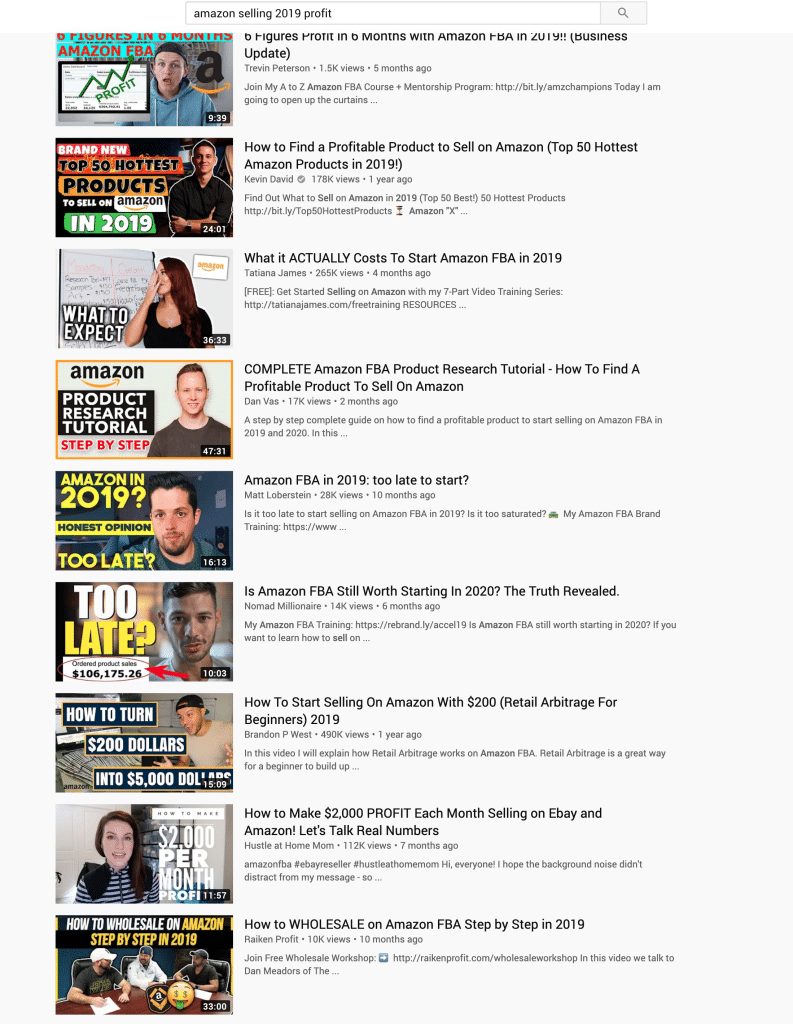The New Year has come and passed, and with it a wave of personal and professional resolutions. Statistically speaking, 80% of resolutions will fail by mid-February, but your Amazon sales goals shouldn’t be among them.
If you did your end-of-year homework right, you have had a chance to review your 2019 numbers and reflect back on your effort. Did you meet your projections? Did you keep track of unforeseen challenges and obstacles that got in your way? How regularly did you evaluate and optimize your approach on Amazon?
Either way, when you are considering who to hire for your Amazon sales agency you’ll want to include explosive growth for an existing product, successful launch of a new line, or turning the tides to reverse a negative trend, we offer 3 essential resolutions to help you take the right steps towards positive results.

3 simple 2020 resolutions to boost Amazon sales .
Slow Down and Think Strategically About Boosting Amazon Sales

There is no shortage of magic formulas promising unbelievable success.
The digital space can feel chaotic. Algorithms are constantly updated; Amazon adjusts prices on average every 10 minutes (2.5 million times a day); and competition evolves rapidly. Amazon sales agencies must strike a balance between analytics, insights, planning, and actual execution, often in real-time in order to find success.
Imagine that instead of running a shop on Amazon, you are revamping a brick & mortar business. You already have inventory, but you need to create a welcoming space for customers. Think about attractive signage. And logistics like cash registers with POS systems in place. Where can you advertise in the local market? Will you have a grand opening? What employees will you need, from sales to managers to janitors to accountants?
In the context of brick & mortar planning, it’s easy to realize that stores seldom ever see an explosion of success after they first open. It can take months or longer to see positive returns, or years of building loyal customers who help you spread by word-of-mouth.
Likewise, there is no simple recipe for immediate success in Amazon, although many would like you to think that there is (see myths in section below). Success takes planning, strategy, and long-term investments. So before you make another move, resolve to be patient. Be persistent, yes, and have faith in a solid strategy with realistic expectations, but above all be patient and plan.
Identify Your Differentiating Value Proposition
The brick & mortar analogy falls apart quickly if you imagine your shop in the middle of mega-mall of 1,000,000 stores, in which 3,000 new stores open every day to sell exactly what you are selling. But that number reflects the reality of Amazon, whose seller lists continue to expand year over year at alarming rates.
No matter what category you sell within, competition is fierce. This makes it easy to fall for two common myths:
- Boosting Amazon Sales will come automatically. There is a common Field of Dreams-style misconception that “if you build it, they will come.” Building organic traffic (and sales) can be like budging a large boulder. It requires time and energy but can eventually gain momentum with the right (smart) strategies. More importantly, like a snowball, the momentum can help it grow larger than you even imagined. We’ve helped clients navigate exponential short-term growth that was so successful it put pressure on their existing supply chain and ability to fulfill Amazon’s massive demand.
- My competitors have a secret sauce, magic software, or other edge over me. They might have an edge while you’re getting started, but it’s not because of something secret and magical. Ads and tips like these (see below) find a handful of success stories rooted in truth and build up promise of mythical, magical sales. The “$5,000/hour seller” is a common one. We aren’t saying it doesn’t happen, but it’s like an animal so rare even unicorns are searching for it.


These alluring myths are not unique to boosting Amazon sales — they are spinoffs of tales seen in every culture around the world, retold and re-imagined with time. Fortunately, this means the old adages and sage wisdom still hold true instead: steer clear of the “get rich quick” schemes and think strategically about your value proposition to customers. We buy into a traditional capitalist mantra: “Hard work, works” (with the right, smart strategies).
We start many conversations with a new potential partner in a similar fashion: “What makes your brand (not just one product) special or unique?” Sometimes the product itself is the differentiator; sometimes it is a new technology. It could be a niche category, or a new spin on a proven industry. Sometimes it is something internal, like a development or logistical innovation. Once we identify what it is, we can ask the critical follow up: how unique or special is it, really?
Whatever it may be, the answer to that question will help form the bedrock for any viable strategy and, therefore, any successful growth in 2020.
Examine the Category & Marketplace
If you’ve considered the core pieces of a long-term strategy and had an honest conversation with yourself about the unique value proposition you offer, the final resolution to get you moving towards your goals is to look honestly at the marketplace for context and validation. We recommend looking at overall size, complexity of your product, and a broad category of “other factors.”
- How big is the competitive market?
There is a counterintuitive line of thought that threatens many sellers. In the spirit of diversifying themselves and hoping to stand out, it is possible to go too far. If the product or specialty you offer is extremely niche, it may not appeal to broader groups who might otherwise become customers. Our data suggests, based on our strategic approaches, that larger market sizes offer more opportunity for success. A no-brainer, right? As long as the strategy supports your efforts.
- How simple or complex is the product?
This goes hand-in-hand with the idea of getting too-niche. Complex products often see additional logistical challenges, such as the potential for more returns (and therefore more hassle). Similarly, products requiring subscription or activation of any kind may deter a buyer from completing the purchase…even if they were on the hook. Simplifying as much as possible, without stripping unique, valuable differentiators, can help facilitate a smoother sales experience.
- Are there other factors to consider?
For example, do trade wars with China (and tariffs) impact your bottom line? Or are there cultural trends, like the rise of CBD products, that you foresee on the horizon? Both obstacles and opportunities often arise from the “other factors” category when you think about the big picture, but both can impact your success.
Add Regular Reviews to Your Plan
Remember, resolutions are different than goals; good resolutions should help you reach the goals you strive for. If you can work strategically to make a plan that is centered around your unique value proposition while considering the larger market context, you are setting yourself up to maximize your success in 2020.
This is not a “set it and forget it” type of process. It’s not one-and-done, either. Help yourself by scheduling regular check-ins to slow down and revisit these steps. Ask what has changed. Review the numbers and look for trends. What else can you do next?
If any of these questions raise additional struggles or concerns for you — now or when you revisit them at your next check-in — don’t hesitate to reach out. Our experts are always just a click away.
